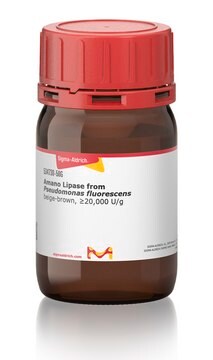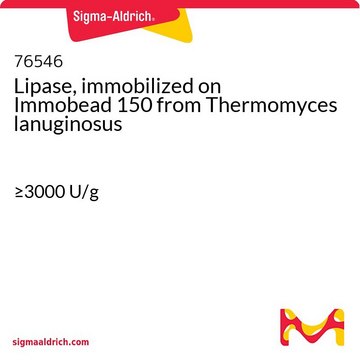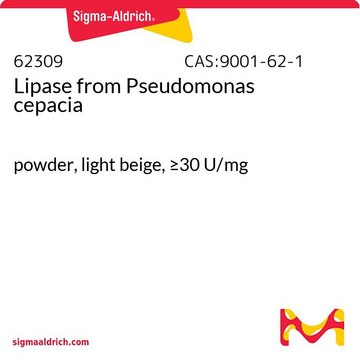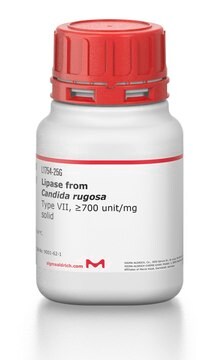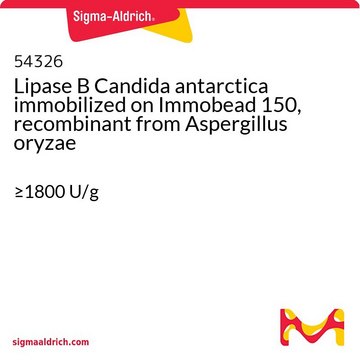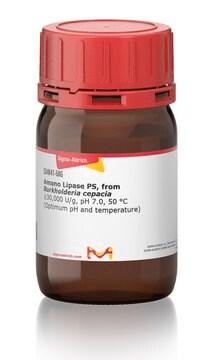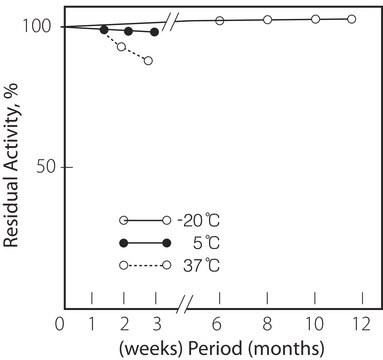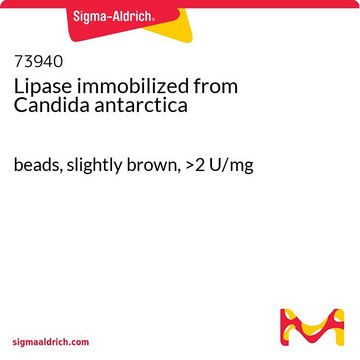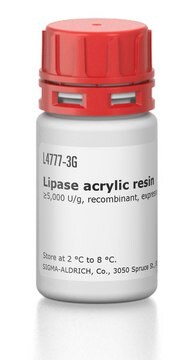54327
Lipase, immobilized on Immobead 150 from Pseudomonas cepacia
≥900 U/g
Synonym(s):
Immobilized Lipase
Sign Into View Organizational & Contract Pricing
All Photos(1)
About This Item
UNSPSC Code:
12352204
NACRES:
NA.54
Recommended Products
biological source
bacterial (Pseudomonas cepacia)
Quality Level
form
powder (or beads)
specific activity
≥900 U/g
color
white to off-white
application(s)
life science and biopharma
storage temp.
2-8°C
Gene Information
Burkholderia spp. ... BURCE16_RS29975(56665765)
General description
Research area: Cell Signaling
Lipases are water-soluble, ester hydrolases. Long aliphatic chain acyl esters of cholesterol (cholesteryl esters), triacyl esters of glycerol (triacylglycerols), acyl esters of long chain alcohols (wax esters), diacyl esters of glycerol (diacylglycerols), and monoacyl esters of glycerol, are some of the common substrates for lipases.
Lipases are water-soluble, ester hydrolases. Long aliphatic chain acyl esters of cholesterol (cholesteryl esters), triacyl esters of glycerol (triacylglycerols), acyl esters of long chain alcohols (wax esters), diacyl esters of glycerol (diacylglycerols), and monoacyl esters of glycerol, are some of the common substrates for lipases.
Application
Lipases are used industrially for the resolution of chiral compounds and the transesterification production of biodiesel.Lipase, immobilized on Immobead 150 from Pseudomonas cepacia has been used in enzymatic hydrolysis of polylactic acid (PLA). It has also been used as biocatalysts in lipase-catalyzed kinetic resolution reactions.
Biochem/physiol Actions
Lipases catalyze the hydrolysis of triacylglycerols into glycerol and free fatty acids.Lipases are known to regulate energy metabolism of the cell. Lipolysis is highly essential for cellular uptake or release of fatty acids (FAs) and glycerol. Gastrointestinal lipolysis catabolizes dietary fat. Vascular lipolysis hydrolyzes lipoprotein-related triglycerides (LTPs) in the blood. In the intracellular domain, lipolysis catalyzes the breakdown of triglycerides (TGs) stored in LDLs for exportation of fatty acids (fat) (fat tissue) or metabolism (non-adipose tissue).
Unit Definition
1 U corresponds to the amount of enzyme which liberates 1 μmol butyric acid per minute at pH 7.5 and 40°C (tributyrin, Cat. No. 91010, as substrate)
Storage Class
11 - Combustible Solids
wgk_germany
WGK 3
flash_point_f
Not applicable
flash_point_c
Not applicable
ppe
Eyeshields, Gloves, type N95 (US)
Choose from one of the most recent versions:
Already Own This Product?
Find documentation for the products that you have recently purchased in the Document Library.
Customers Also Viewed
Florian Golombek et al.
ACS omega, 6(43), 29192-29200 (2021-11-09)
Deracemizations are clearly preferable to kinetic resolutions in the production of chiral molecules from racemates, as they allow up to 100% chemical and optical yield. Here we present a new process route for multienzymatic deracemizations that is relevant for reaction
Song-Hua Hu et al.
Cell reports, 38(11), 110509-110509 (2022-03-17)
Protein fatty acylation regulates numerous cell signaling pathways. Polyunsaturated fatty acids (PUFAs) exert a plethora of physiological effects, including cell signaling regulation, with underlying mechanisms to be fully understood. Herein, we report that docosahexaenoic acid (DHA) and eicosapentaenoic acid (EPA)
Guan-Chun Chen et al.
Biotechnology letters, 33(3), 525-529 (2010-11-04)
Triacylglycerol lipase from Pseudomonas cepacia and Fe(3)O(4) magnetic nanoparticles were encapsulated simultaneously within biomimetic silica through the catalysis of polyallylamine. The encapsulation efficiency reached 96% with an activity recovery of 51%. After 5 h at 37°C, the activities of the
Industrial applications of microbial lipases
F. Hasan et al.
Enzyme and Microbial Technology, 39, 235-251 (2006)
Our team of scientists has experience in all areas of research including Life Science, Material Science, Chemical Synthesis, Chromatography, Analytical and many others.
Contact Technical Service
